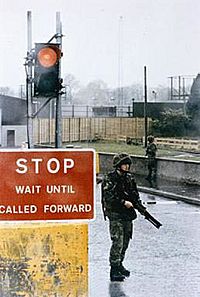Attack on Cloghoge checkpoint facts for kids
Quick facts for kids Attack on the Cloghoge checkpoint |
|||||||
|---|---|---|---|---|---|---|---|
| Part of the Troubles and Operation Banner | |||||||
 Entrance to a British Army checkpoint near Newry, late 1980s |
|||||||
|
|||||||
| Belligerents | |||||||
| Commanders and leaders | |||||||
| Unknown | Lt. Andrew Rawding | ||||||
| Strength | |||||||
| 2 active service units 1 railway bomb |
24 soldiers in complex 2 patrols |
||||||
| Casualties and losses | |||||||
| None | 1 killed 23 wounded |
||||||
The attack on Cloghoge checkpoint was a unique bomb attack. It happened on May 1, 1992. The Provisional Irish Republican Army (IRA) used a special railway bomb. They targeted a British Army checkpoint. This checkpoint was a permanent security post. It was located near the village of Cloghoge in County Armagh, Northern Ireland.
The IRA used a van fitted with train wheels. They put a large bomb inside it. The van was then driven along a railway line. It went right up to the checkpoint. The explosion killed one British soldier. Twenty-three other soldiers were also hurt. The entire checkpoint was completely destroyed.
The Cloghoge Checkpoint Attack
How the Attack Happened
On the night of April 30, a group of four IRA members took over a family's home. This happened in Killean, County Armagh. They took a mechanical excavator. This machine was used to build a ramp. The ramp led up to the Dublin–Belfast railway line. This railway line ran next to the main road.
At the same time, other IRA members stole a dark van. They took it from Dundalk, County Louth. They loaded the van with about 2,200 pounds of homemade explosives. The van was then fitted with special wheels. These wheels allowed it to run on the railway tracks. The excavator lifted the van onto the railway. It also helped build a ramp of stones and wood. This ramp made sure the van was lined up with the tracks.
The van was then driven about 800 meters north. A long wire, about a mile long, was attached to the bomb. This wire would be used to set off the bomb. Other IRA members set up roadblocks. They did this on both sides of the border. This was to keep people away from the target. Some IRA members wore police uniforms at their checkpoints.
Around 2:00 AM, the van was set to move slowly. It was aimed at the Romeo-One-Five (R15) military checkpoint. This checkpoint was on the main road, next to the railway. The IRA had studied the checkpoint. They knew that the railway side had no strong blast walls.
A British Army patrol was about 300 yards south of the checkpoint. They heard a sound like a train. A person passing by told another patrol that hooded men had stopped his car. Then, a soldier in a watchtower saw the van on the tracks. He quickly warned the checkpoint by radio. The soldier on guard at the checkpoint, Fusilier Andrew Grundy, saw the van coming. He warned the other soldiers. They quickly ran to safety. Grundy tried to stop the van by shooting at it, but it kept coming.
An IRA member was on a hill south of the checkpoint. He waited for the van to reach its target. He used the van's lights to guide it. The IRA later said they used a device to stop the van. It stopped right next to the checkpoint. The IRA volunteer then radioed his team. He told them to set off the bomb. At 2:05 AM, the bomb exploded. It completely destroyed the checkpoint. A heavy guard post, weighing 10 tons, was thrown 12 yards away. Fusilier Grundy was killed right away. But the other 23 soldiers were inside a strong concrete bunker. They survived the huge blast, but all were injured.
What Happened After
Fusilier G. A. Colman received a special award. He was praised for helping rescue Fusilier Grundy's body. He also helped the wounded soldiers.
The British Army's official report called this a "well-planned and well-executed attack." They said it showed how "imaginative, innovative and capable" the IRA was in that area.
The Cloghoge checkpoint was never opened again. A smaller checkpoint was built a few miles to the west. While this new checkpoint was being built, the IRA attacked it. They used rockets on July 30, 1992. They also used mortars on August 6. This new checkpoint cost £7 million. However, it was removed in 1998. This happened right after the Good Friday Agreement.
See also
- Chronology of Provisional Irish Republican Army actions (1992-1999)
- Improvised tactical vehicles of the Provisional IRA
- Attack on Derryard checkpoint
- Glenanne barracks bombing
- Drummuckavall Ambush
- Proxy bomb

